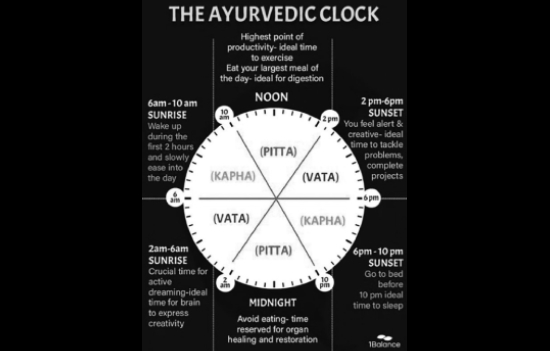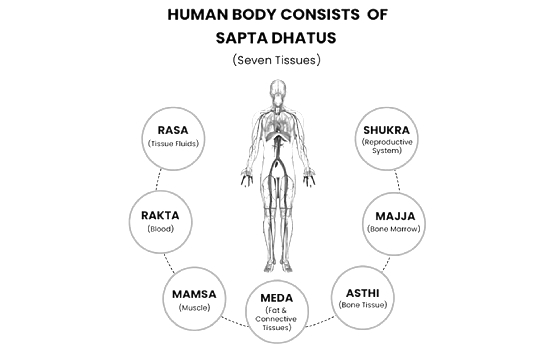- This article briefly tells about the concepts of Ayurveda, its evolution
and basis. It explains the concept of Sapta Dhatus.
The body, when combined with the sense organs, mind, and soul, becomes life. - Charak Samhita
There has been something of a renaissance in the field of Ayurveda. As the
foremost ancient Indian system of medicine, Ayurveda is widely practiced and increasingly
recognised not just in India but across the world.
This article was
first published in the Bharatiya Vidya
Bhavan Journal.
Its foundation lies in the spiritual texts of ancient India, the Vedas (books of wisdom), which date back at least 5,000 years and are revered as some of the world’s oldest literature. In particular, the following mantra from the Yajurveda holds special significance:

Ayurveda is one of the most ancient and comprehensive systems of healthcare. The term comes from the Sanskrit words ayus (life) and veda (knowledge), literally meaning “knowledge” or “science of life.” Increasingly, modern science is recognising why the Ayurvedic approach to health is both holistic and effective.
Ayurveda’s core philosophy is the idea that within each of us lies the capacity to live happy, balanced lives, free of pain and disease. But to achieve this seemingly superhuman feat, we have to cultivate the quality of what is called self-referral—a state of being connected to oneself in ways that allow the optimisation of every aspect of life.
In other words, it means being able to effortlessly
know and manage who you are, what your body type is, what lifestyle choices
suit you, how to process emotions and stress, and how to interact with the
fundamental qualities of nature around you while maintaining balance.

The Vaisheshika school emphasised the inferences and perceptions that should be drawn about a patient ’s pathological condition for treatment. In contrast, the Nyaya school advocated that one should acquire extensive knowledge of the patient ’s condition and the disease before beginning treatment. The Vaisheshika school classified the attributes of any object into six types: dravya (substance), visesa (particularity), karma
(activity), samanya (generality), samavaya (inherence), and guna (quality).
Later, the Vaisheshika and Nyaya schools merged, giving rise to the Nyaya–Vaisheshika school, which brought glory to ancient knowledge and contributed to the dissemination of Ayurveda.
Even before these schools were established, the origin of Ayurveda was
considered divine, traced to the Hindu god Brahma, the creator of the universe.
It is believed that Brahma passed this holistic knowledge of healing to sages
for the well-being of mankind. From the sages, the knowledge of traditional
medicine was passed down to their disciples in succession, and later to the common
people through oral tradition and eventually in written form. The healing
properties of herbs were often composed as short poems or stanzas, called shlokas.
Current knowledge of Ayurveda is primarily based on the ‘Great Triad’ of texts, the Brihattrayi, which comprises the Charaka Samhita, Sushruta Samhita, and Ashtanga Hridaya. These works describe the fundamental principles and theories from which modern Ayurveda has evolved.
Ayurveda believes that the entire universe is composed of five elements: Vayu (air), Jala (water), Akash
(space or ether), Prithvi (earth),
and Teja (fire). These five elements,
known as the Pancha Mahabhootas, are
believed to form the three basic humours of the human body in varying combinations.
The three humours-Vata dosha, Pitta dosha and Kapha dosha—are collectively called the Tridoshas, which govern the body’s fundamental physiological functions. Each principal dosha also has five sub-doshas.
According to Ayurveda, the human body is made up of the Sapta Dhatus (seven primary bodily tissues):
Rasa (plasma/lymph), Rakta (blood), Mamsa (muscle), Meda (fat),
Asthi (bone), Majja (marrow), and Shukra
(reproductive tissue). It also comprises the three malas (waste products): purisha
(faeces), mutra (urine), and sweda (sweat).
These seven tissues work in coordination with one another to ensure proper
physiological functioning of the body.
The Rakta Dhatu corresponds to blood,
regulating circulation and supplying essential components to the body. The Mamsa Dhatu (muscle tissue) provides
structural support through skeletal muscles, while the Meda Dhatu represents adipose (fat) tissue. The Asthi Dhatu forms the bones of the body,
and the Majja Dhatu comprises the
bone marrow and fluids that support the nourishment and functioning of bones.
Finally, the Shukra Dhatu governs the
functioning of the reproductive organs.
Vata dosha regulates cellular transport, electrolyte balance, and elimination of
waste, and is aggravated by dryness. Pitta
dosha regulates body temperature, optic nerve coordination, and hunger and
thirst, and is aggravated by heat. Kapha
dosha is increased by sweet and fatty foods, and provides lubrication to
the joints for proper functioning.
In Ayurveda, Vata governs catabolism,
Pitta regulates metabolism, and Kapha sustains anabolism. For good
health, balance must be maintained among the three doshas and related factors.
Any imbalance is believed to cause illness or disease.
In Ayurveda, it is believed that a perfect balance between the natural
elements and the Tridoshas of the human body must be maintained for a healthy
life, in accordance with the principles of divine wisdom.
Even modern research has shown remarkable instances of self-healing in
animals. An orangutan, for example, was observed treating a painful wound on
its cheek by chewing plant leaves known for their pain-relieving and healing properties,
applying the juice to the wound, and then using the leaves as a poultice to
cover the injury.
Research biologist Isabelle Laumer remarked: “This case represents the first known case of active wound treatment in a wild animal with a medicinal plant.”

This reminds us of the famous saying of Swami Vivekananda: “Instinct, reason, and inspiration are the three instruments of knowledge.” Evidently, it is as unfair to judge Ayurveda solely through the lens of Western research methods as it is to interpret history only through a Western prism. After all, India has relied on its indigenous systems of treatment for centuries. Like Yoga, Ayurveda has gained legitimacy through its practical applications over millennia. The countless “trial runs” across these long periods should themselves be regarded as sufficient to accord Ayurveda its due approval and recognition.
Yet, the influence of the pharmaceutical lobby has often held human health hostage to wealth and profit, dismissing and deriding Ayurveda in order to protect its own interests. History, however, records striking examples of Ayurvedic efficacy—for instance, the case of Budshah, a king of Kashmir, who developed a boil on his groin that no branch of medicine could cure. It was only Shri Bhatt, an Ayurveda specialist, who succeeded in healing the king with his lotion
To read all articles
by Author
To read all
articles on Ayurveda
This article was first published in the Bhavan’s Journal, October 16-31, 2025 issue. This article is courtesy and copyright Bhavan’s Journal, Bharatiya Vidya Bhavan, Mumbai-400007. eSamskriti has obtained permission from Bhavan’s Journal to share. Do subscribe to the Bhavan’s Journal – it is very good.